Kenneth C. Davis's Blog, page 77
June 27, 2015
Whatever Became of 56 Signers? (4th in a series)

Fair Copy of the Draft of the Declaration of Independence (Source New York Public Library)
…We mutually pledge to each other our Lives, our Fortunes , and our Sacred Honor.
Part 4 in a series that begins here.
Father and grandfather of presidents. A simple farmer. A workaholic. The next five signers, in alphabetical order:
-Benjamin Harrison (Virginia) A member of the Virginia aristocracy, he was a well-to-do planter, around 50 at the the signing. Although his famed Berkeley Plantation on the James River was supposedly destroyed during the Revolution, it clearly survived. So did Harrison, who went on to serve three terms as governor of Virginia before hs death in 1791 at age 65. Besides his role in the July 2 and 4 votes in Philadelphia, he is mostly distinctive as the father of 9th president William Henry Harrison and grandfather of namesake Benjamin Harrison, the 23rd president.
-John Hart (New Jersey) Described as a well-meaning “Jersey” farmer with little education, Hart was a 65 year old planter at the time of the signing, and devoted to the patriot cause. Although supposedly hounded by the British during the war, he was later able to entertain General Washington and allow 12,00 troops to camp in his fields in 1778. He died of kidney stones in 1779, aged 68.
-Joseph Hewes (North Carolina) Born in New Jersey, he moved to North Carolina and was a 46 year old Quaker merchant at the signing. At first a reluctant patriot, he broke with the Quakers over the possibility of a violent rebellion and was considered a key influence in Congress by John Adams. His shipping experience was significant enough for him to be described as the first “secretary of the Navy,” responsible for getting his friend John Paul Jones a commission. Working relentlessly for the Congress, Hewes fell sick and died in 1779 at age 49 and was deeply mourned by his Congressional colleagues.
-Thomas Heyward, Jr. (South Carolina) Son of a wealthy planter, he was a 30 year old lawyer at the signing. Heyward counts as one of the few signers actually captured by the British, who then took his enslaved people, apparently shipping them to bondage in the West Indies. Initially paroled (released under an agreement), he was later taken aboard a prison ship and then held in St. Augustine, Florida under a form of house arrest until released in a prisoner exchange. While a hostage, he is credited with writing verses to a song called “God Save the Thirteen States.” He dabbled in politics after the war, but focused on rebuilding his family plantation where he died at 63 in 1809.
-William Hooper (North Carolina) Born in Boston, he was a 34 year old attorney who had moved South at the signing. He missed the key July vote but returned to sign the Declaration in August. Hooper was one of the signers who suffered losses during the war when the British invaders evacuating the Wilmington, North Carolina area and destroyed his home. He later pressed for ratification of the Constitution but lacked popularity in his adopted state and, suffering from a variety of illnesses, including malaria, died in 1790 at age 48.

Don’t Know Much About® the American Presidents (Hyperion Paperback-April 15, 2014)
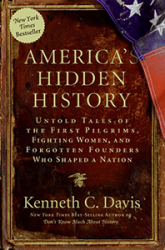
America’s Hidden History, includes tales of “Forgotten Founders”
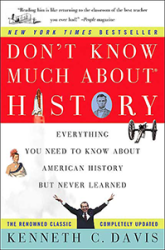
Don’t Know Much About® History: Anniversary Edition (Harper Perennial and Random House Audio)
June 26, 2015
Whatever Became Of…56 Signers? (3d in series)

Fair Copy of the Draft of the Declaration of Independence (Source New York Public Library)
Part 3 of a series of posts about the fates of the signers of the Declaration of Independence. A printer, a politician, a duelist, a Connecticut Yankee and the most famous signature in U.S. history. The next five in alphabetical order:
-Benjamin Franklin (Pennsylvania) America’s most famous man in 1776, Franklin was 70 years old at the time of the signing. Printer, publisher, writer, scientist, diplomat, philosopher –he was the embodiment of the Enlightenment ideal. A member of the draft committee that produced the Declaration, Franklin was a central figure in the independence vote and then helped the war effort by winning crucial French support for the America cause. But he lost no Fortune, reportedly tripling his wealth during the conflict. Franklin returned to the scene of the Declaration’s passage in 1787 to help draft the Constitution.. When he died at age 84 in 1790, his funeral was attended by a crowd equal to Philadelphia’s population at the time. Read more on Franklin at this National Park Service site.
-Elbridge Gerry (Massachusetts) A 32 year old merchant from Marblehead, Gerry (pronounced with a hard G like Gary) is much more famous for later dividing Massachusetts into oddly-shaped voting districts as the state’s governor. A cartoonist compared the districts to a salamander and the word “gerry-mandering” was born. Though he voted for independence, Gerry was not present to sign in August, signing later in the fall of 1776, He profited from the war and later joined the Massachusetts delegation to the Constitutional convention in 1787, although he refused to sign the Constitution. He became James Madison’s second vice president in 1812, but died in office in 1814 at age 70.
-Button Gwinnett (Georgia) An English-born plantation owner and merchant, he was 41 at the time of the signing. And didn’t last much longer. A political argument with a Georgia general led to a duel in which Gwinnett was mortally wounded. He died in 1777 at age 42, the second of the signers to die. (John Morton of Pennsylvania was first.)
-Lyman Hall ( Georgia) A Connecticut Yankee physician transplanted to Georgia plantation owner, Hall was 52 years old at the signing. A vocal patriot when Georgia was far more hesitant about independence, he first came to Philadelphia as a nonvoting delegate. Hall’s plantation was destroyed during the war when the British made their punishing attacks on the South. He later served as Georgia’s governor, dying at age 66 in 1790.
-John Hancock (Massachusetts) Born into a poor parson’s family in Lexington (National Parks Service site) , Hancock was sent to live with a wealthy uncle when his father died. He inherited his uncle’s shipping business and was one of America’s wealthiest men by the time he was thirty. A patriot leader in Boston, it was Hancock and Samuel Adams who the British sought to capture on that April 1775 night when the war began. President of the Continental Congress when independence was declared, he was 39 at the time of the signing. The outsized signature on the document cemented his fame in American lore. After the war, Hancock was governor of Massachusetts at the time of his death in 1793 at age 56.
Longer sketches of these signers can be found at this National Park Service site.

Don’t Know Much About® History: Anniversary Edition (Harper Perennial and Random House Audio)

America’s Hidden History, includes tales of “Forgotten Founders”

Don’t Know Much About® the American Presidents (Hyperion Paperback-April 15, 2014)
June 25, 2015
Whatever Became Of…56 Signers? (One in a series)
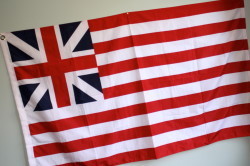
The Grand Flag of the Union, the “first American flag,” originally raised in 1775 and later by George Washington in early 1776 in Boston. The Stars and Stripes did not become the “American flag” until June 14, 1777. (Author photo © Kenneth C. Davis)
TODAY, June 25, 2015, I will begin reposting this series about the 56 signers of the Declaration.
…We mutually pledge to each other our Lives, our Fortunes , and our Sacred Honor.
Strong words that conclude the Declaration of Independence, adopted by the Continental Congress on July 4, 1776.
There is little question that men who signed that document were putting their lives at risk. The identity and fates of a handful of those signers is well-known. Two future presidents –Adams and Jefferson– and America’s most famous man, Benjamin Franklin, were on the Committee that drafted the document.
But the names and fortunes of many of the other signers, including the most visible, John Hancock, are more obscure. In the days leading up to Independence Day, I will offer a thumbnail sketch of each of the signers in alphabetical order. Some prospered and thrived; some did not: How many of those signers actually paid with their lives, fortunes and sacred honor?
-John Adams (Massachusetts) Aged 40 when he signed, he went on to become the first vice president and second president of the United States. Adams died on the 50th anniversary of the Declaration in 1826 at age 90. (Jefferson died that same day)
-Samuel Adams (Mass.) Older cousin to John, Samuel Adams was 53 at the signing. He went on to a career in state politics, initially refused to sign the Constitution because it lacked a Bill of Rights, and was governor of Massachusetts. He died in 1803 at 81.
-Josiah Bartlett (New Hampshire) Inspiring the name of the fictional president of West Wing fame on TV, Bartlett was a physician, aged 46 at the time of the signing. He helped ratify the Constitution in his home state, giving the document the necessary nine states to become the law of the land. Elected senator he chose to remain in New Hampshire as governor. Three of his sons and other descendants also became physicians. He died in 1795 at age 65.
-Carter Braxton (Virginia) A 39-year-old plantation owner, Braxton was looking to invest in the slave trade before the Revolution. Initially reluctant about independence, he helped fund the rebellion and lost a considerable fortune during the war –not because he was a signer, but because of shipping losses during the war itself. He later served in the Virginia legislature and died in 1797 at age 61, far less wealthy than he had been, but also far from impoverished.
-Charles Carroll of Carrollton (Maryland) A plantation owner, 38 years old and one of America’s wealthiest men at the signing, Carroll was the only Roman Catholic signer and the last signer to die. Owner of hundreds of slaves, Carroll considered freeing some of them before his death and later introduced a bill for gradual abolition in Maryland, which had no chance of passage. At age ninety-one, he laid the cornerstone of the Baltimore and Ohio Railroad as a member of its board of directors. He died in 1832 at age 95.
Longer biographical sketches of the Declaration’s signers can be found at this National Park Service site. And read more about the Declaration and the signers in:

DON’T KNOW MUCH ABOUT® THE AMERICAN PRESIDENTS (HYPERION PAPERBACK APRIL 15, 2014)

Don’t Know Much ABout® History: Anniversary Edition (Harper Perennial and Random House Audio)
Whatever Became Of…56 Signers? (2d in a series)
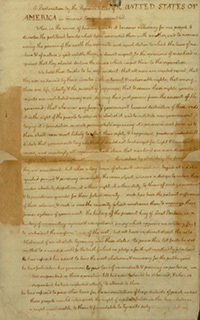
Fair Copy of the Draft of the Declaration of Independence (Source New York Public Library)
…We mutually pledge to each other our Lives, our Fortunes , and our Sacred Honor.
Here are the next five Signers of the Declaration, continuing in alphabetical order:
-Samuel Chase (Maryland) A 35 year old attorney, Chase has the distinction of being among those signers who didn’t vote on July 4; he signed the later printed version in August. Accused of wartime profiteering but never tried or convicted, he later went broke from speculation and settled into law practice. George Washington appointed him to the Supreme Court, where the became the first justice to be impeached –although he was acquitted. He died in 1811 at age 70.
-Abraham Clark (New Jersey) An attorney, 50 years old at the signing, Clark had two sons who were captured and imprisoned during the war; one on on the notorious British prison ship Jersey and the other in a New York jail cell. Clark served in Congress on and off and opposed the Constitution’s ratification until the Bill of Rights was added. He died in 1794 at age 68.
-George Clymer (Pennsylvania) A 37 year old merchant the time of the signing, Clymer was a well-heeled patriot leader who helped fund the American war effort. He was also elected to Congress after the July 2 independence vote, signing the Declaration on August 2. He belongs to an elite group who signed both the Declaration and the Constitution. (The others were Roger Sherman of Conn,; George Read of Del.; and Franklin, Robert Morris and James Wilson, all of PA.) He continued to prosper after the war and died in 1813 at age 74.
-William Ellery (Rhode Island) A modestly successful merchant turned attorney aged 48 at the signing,, Ellery replaced an earlier Rhode Island delegate who died of small pox in Philadelphia. (Smallpox killed more Americans than the war did during the Revolution.) A dedicated member of Congress during the war years, Ellery saw his home burned by the British although it is thought unlikely they knew it was the home of a signer. He was rewarded after the war by President Washington with the lucrative post of collector for the port of Newport which he held for three decades. He died in 1829, aged 92, second in longevity among signers after Carroll. (See previous post.)
-William Floyd (New York) A 41 year old land speculator born on Long Island, New York, Floyd abstained from the July 2 independence vote with the rest of the New York delegation, but is thought to be the first New Yorker to sign the Declaration on August 2. Reports that his home on Fire Island was destroyed by the British were exaggerated, although it was used as a stable and barracks by the occupying Redcoats. (It is now part of a Fire Island National Park.) Floyd served in the first Congress before moving to western New York where he owned massive land tracts and where he died at age 86 in 1821.
Longer sketches of these signers can be found at this National Park Service site.
Read more about the Revolution, Declaration and “Forgotten Founders” in these books:

Don’t Know Much About® the American Presidents (Hyperion Paperback-April 15, 2014)

Don’t Know Much About® History: Anniversary Edition (Harper Perennial and Random House Audio)

America’s Hidden History, includes tales of “Forgotten Founders”
June 23, 2015
“War Stories”-The Hidden History of America At War
This video is a brief introduction to my new book, THE HIDDEN HISTORY OF AMERICA AT WAR: Untold Tales from Yorktown to Fallujah (published May 5, 2015 by Hachette Books and Random House Audio)
“His searing analyses and ability to see the forest as well as the trees make for an absorbing and infuriating read as he highlights the strategic missteps, bad decisions, needless loss of life, horrific war crimes, and political hubris that often accompany war.”
–Publishers Weekly *Starred Review Link Full Review
More Advance Praise for THE HIDDEN HISTORY OF AMERICA AT WAR
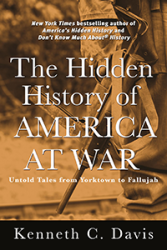
The Hidden History of America At War-May 5, 2015 (Hachette Books/Random House Audio)
“There’s only one person who can top Kenneth C. Davis—and that’s Kenneth C. Davis. With The Hidden History of America at War, he’s composed yet another brilliant, thought-provoking, and compelling book. . . Davis offers a hard-hitting and sometimes critical look at some of the most consequential wartime decisions made by presidents and policy makers, but his admiration and respect for the men and women who have served and sacrificed so much for this nation is unwavering.”
—Andrew Carroll, editor of the New York Times-bestsellers War Letters and Behind the Lines
“With his trademark storytelling flair, Kenneth C. Davis illuminates six critical, but often overlooked battles that helped define America’s character and its evolving response to conflict. This fascinating and strikingly insightful book is a must-read for anyone who wants to better understand our nation’s bloody history of war.”
—Eric Jay Dolin, author of Leviathan and When America First Met China
“A fascinating exploration of war and the myths of war. Kenneth C. Davis shows how interesting the truth can be.”
—Evan Thomas, New York Times-bestselling author of Sea of Thunder and John Paul Jones
June 22, 2015
“Juneteenth Is for Everyone” (New York Times Opinion)
This article recounting the history of “Juneteenth” was published in the New York Times online edition n Friday June 19, 2015.
SOME two months after Gen. Robert E. Lee surrendered on April 9, 1865, effectively ending the Civil War, Maj. Gen. Gordon Granger steamed into the port of Galveston, Tex. With 1,800 Union soldiers, including a contingent of United States Colored Troops, Granger was there to establish martial law over the westernmost state in the defeated Confederacy.
On June 19, two days after his arrival and 150 years ago today, Granger stood on the balcony of a building in downtown Galveston and read General Order No. 3 to the assembled crowd below. “The people of Texas are informed that, in accordance with a proclamation from the Executive of the United States, all slaves are free,” he pronounced.
That was the beginning of a celebration of emancipation that would come to be called “Juneteenth.” Read the complete article, “Juneteenth is for Everyone” here.
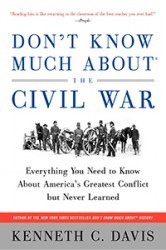
Don’t Know Much About the Civil War (Harper paperback, Random House Audio)

Don’t Know Much About® History: Anniversary Edition (Harper Perennial and Random House Audio)
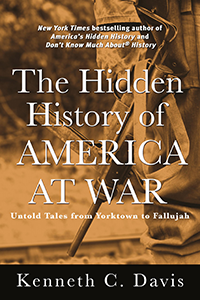
The Hidden History of America At War-May 5, 2015 (Hachette Books/Random House Audio)
June 20, 2015
Who Said It? (6/21/2015)
President Harry S. Truman, “Statement on the Situation in Korea” (June 27, 1950)
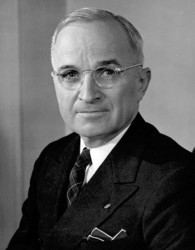
President Harry S. Truman
(Photo: Truman Library)
IN KOREA the Government forces, which were armed to prevent border raids and to preserve internal security, were attacked by invading forces from North Korea. The Security Council of the United Nations called upon the invading troops to cease hostilities and to withdraw to the 38th parallel. This they have not done, but on the contrary have pressed the attack. The Security Council called upon all members of the United Nations to render every assistance to the United Nations in the execution of this resolution. In these circumstances I have ordered United States air and sea forces to give the Korean Government troops cover and support.
The attack upon Korea makes it plain beyond all doubt that communism has passed beyond the use of subversion to conquer independent nations and will now use armed invasion and war. It has defied the orders of the Security Council of the United Nations issued to preserve international peace and security.
Source and Complete Text:Harry S. Truman: “Statement by the President on the Situation in Korea,” June 27, 1950. Online by Gerhard Peters and John T. Woolley, The American Presidency Project.
June 15, 2015
THE HIDDEN HISTORY OF AMERICA AT WAR-Speaking Calendar
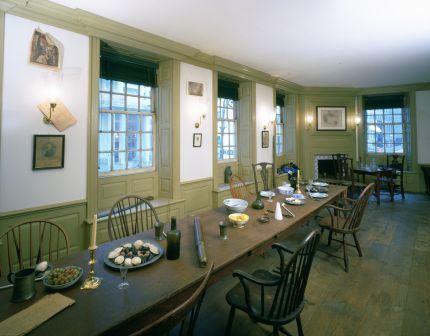
The Long Room at the historic Fraunces Tavern Museum
List of Upcoming Speaking Engagements:
June 18 Mount Vernon Public Library, Mount Vernon, NY 6:30 PM
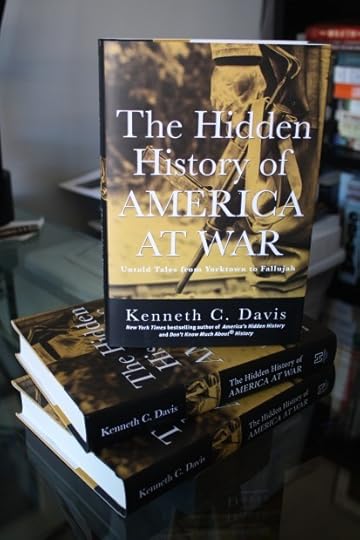
THE HIDDEN HISTORY OF AMERICA AT WAR: Untold Tales from Yorktown to Fallujah (May 5-Hachette Books/Random House Audio)
June 14, 2015
Who Said It (6/14/2015)
General George Washington, “Letter to the President of the Continental Congress” (September 2, 1776)
The United States Army was born on June 14, 1775 when the Continental Congress called for companies of riflemen and adopted the militiamen in Cambridge, Massachusetts as the Continental Army, the first United States Army. This date is considered the birthday of the U.S. Army. George Washington was named to command the army on June 15, 1775.
A little more than a year later, Washington was deeply troubled by the troops because the militiamen were undisciplined and eager to leave as soon as their enlistments were up.

General George Washington, “Letter to the President of the Continental Congress” (September 2, 1776)
The Militia, instead of calling forth their utmost efforts to a brave and manly opposition, in order to repair our Losses, are dismayed, Intractable and Impatient to return. Great numbers of them have gone off, in some instances almost by whole Regiments, by half ones and by Companies at a Time. This circumstance of itself, Independent of others, when fronted by a well appointed Enemy, superior in number to our whole collected force, would be sufficiently disagreeable, but when their example has Infected another part of the Army, When their want of discipline and refusal, of almost every kind of restraint and Government, have produced a like conduct but too common to the whole, and an entire disregard of that order and Subordination necessary to the well doing of an Army, and which had been inculcated before, as well as the nature of our Military establishment would admit of, our Condition is still more Alarming, and with the deepest concern I am obliged to confess my want of confidence, in the generality of the Troops.
Source: Library of Congress
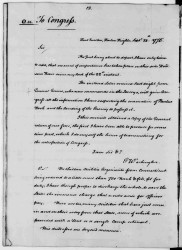
A few weeks later Washington would again write to John Hancock:
To place any dependance upon Militia, is, assuredly, resting upon a broken staff.
Read more about Washington, the militia and the creation of the U.S. Army in THE HIDDEN HISTORY OF AMERICA AT WAR.

The Hidden History of America At War (Hachette Books Random House Audio)
June 13, 2015
Flag Day and Mr. Madison’s War
(A repost of a video made a few years ago but always timely. Filmed, directed and edited by Colin Davis)
In June 1812, Congress declared war on Great Britain. It would be derided as “Mr. Madison’s War.”
It is also appropriate to note that today – June 14– is Flag Day, the day that the Continental Congress adopted the Stars and Stripes as the nation’s flag in 1777.
These two landmarks come together because it was during the War of 1812 that America got the words that eventually became its national anthem –with music borrowed from an old English drinking song. Almost from the outset, the song has been butchered at baseball games and Super Bowls.
At war with England for the second time since 1776, the United States was ill-prepared for fighting and the British were preoccupied with a war with France. So it was a fitful few years of war.
But the conflict produced an iconic American moment in September 1814. Francis Scott Key was an attorney attempting to negotiate the return of a civilian prisoner held by the British who had just burned Washington DC and had set their sights on Baltimore. As the British attacked the city, Key watched the naval bombardment from a ship in Baltimore’s harbor. In the morning, he could see that the Stars and Stripes still flew over Fort McHenry. Inspired, he wrote the lyrics that we all know –well, at least some of you probably know some of them.
But here’s what they didn’t tell you:
Yes, Washington, D.C. was burned by the British in 1814, including the President’s Mansion which would be rebuilt and later come to be called the “White House.” But Washington was torched in retaliation for the burning of York –now Toronto—in Canada earlier in the war.
Yes, Key wrote words. But the music comes from an old English drinking song. Good thing it wasn’t 99 Bottles of Beer on the Wall. Here’s a link to the original lyrics of the drinking song To Anacreon in Heaven (via Poem of the Week).
The Star Spangled Banner did not become the national anthem until 1916 when President Wilson declared it by Executive Order. But that didn’t really count. In 1931, it became the National Anthem by Congressional resolution signed by President Herbert Hoover.,
Now here are two other key –no pun intended– events related to Flag Day, June 14:
•In 1943, the Supreme Court ruled that schoolchildren could not be compelled to salute the flag if it conflicted with their religious beliefs
•In 1954 on Flag Day, President Eisenhower signed the law that added the words “under God” to the Pledge of Allegiance.
Learn more about Fort McHenry, Key and the Flag that inspired the National Anthem from the National Park Service.
The images and music in this video are courtesy of the Smithsonian Museum of American History which has excellent resources on the flag that inspired Key.
This version of the anthem is on 19th century instruments:
http://americanhistory.si.edu/starspangledbanner/mp3/song.ssb.dsl.mp3
The history of the War of 1812, including a Timeline of major events, is explored in greater depth in the Anniversary edition of Don’t Know Much About History, now available in paperback.
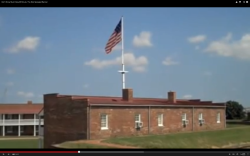
Fort McHenry-Baltimore Harbor (Video frame by Colin Davis)



